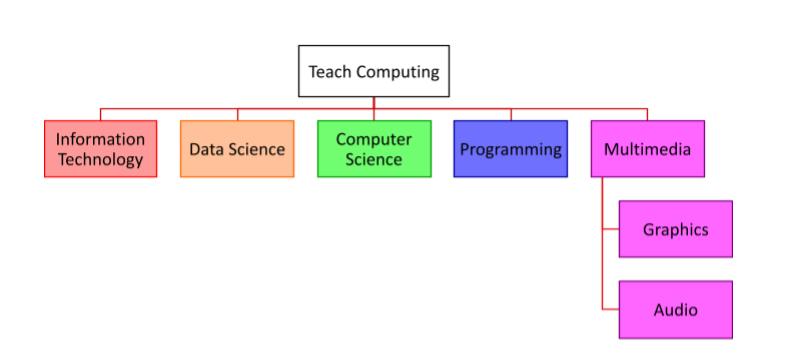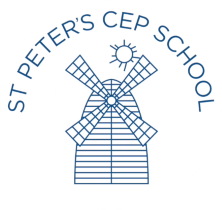Computing
Intent for Computing at St Peter’s
At St Peter’s we recognise that technology is everywhere and is an integral part of everyday life. We aim to deliver a broad and balanced computing curriculum that is discreetly taught as a subject within its own right but also has cross-curricular links to other subjects such as maths, English, science, design technology, PSHE and art. We want to model and educate our students in regard to how to use technology effectively, safely, responsibly and positively. At St. Peter's, we have chosen to use the Teach Computing curriculum as we recognise that technology changes at a rapid pace and this curriculum is regularly updated to keep up to date with the advancements in computing and technology. The Teach Computing curriculum starts in year 1 and therefore, we have selected the 'Firm Foundations' curriculum and Barefoot computing for the EYFS, which aligns with the requirements for the EYFS and with the Teach Computing curriculum. Our teaching equips pupils with the necessary knowledge and skills to responsibly, creatively and competently use technology for all its positive uses. We want our students to leave St Peter’s as digitally literate and effective in their ability to use technology for all its positive benefits in the modern world.
The computing curriculum is split into five key areas which are focused on and revisited throughout our computing programme of study from the firm foundations in Year R to Year 6 at St Peter’s, and include:

We want our pupils to have a breadth of experience to develop their understanding of themselves as individuals within their community but also as members of a wider global community and as responsible digital citizens.
Implementation of our Computing Curriculum at St Peter’s
Across the year at St Peter’s, our children will study a range of different topics and these topics are studied in-depth for a seasonal term and each of these terms has a unique focus.
To facilitate progression of learning, comprehensive computing knowledge and skills progression, this document has been created for teachers, which clearly shows progression across the years and complete coverage of the NC.
Every year, children will continually revisit prior learning from year to year but also from lesson to lesson. Knowledge organisers are available for each unit of study to help students retain the paramount information. Assessment of learning is provided at the end of each lesson and unit to ensure students' learning is being embedded and misconceptions can be addressed.
Being safe on the internet is paramount in our teaching with children and at St. Peter's, we realise that children need to have correct online safety education to be ready for the connected world. The SCARF PSHE curriculum thoroughly and regularly covers this area of learning. However, we reinforce this teaching through our computing curriculum, so that it is embedded as a cross-curricular feature and children can become armed with the necessary knowledge and skills to make informed choices and know where to ask for help if needed.
We look to enhance children’s learning and practical knowledge of computing through whole school celebrations such as Internet Safety Day and extracurricular activities such as Jamcoding Computing Club, Touch-Typing Club and the development of Digital Leaders.
Impact of our Computing Curriculum at St Peter’s
Once embedded, this spiral curriculum will not only develop knowledge, skills and key vocabulary about Computing, but children will also be able to communicate confidently about their own learning journey; having the necessary skills and growing understanding of how to make improvements to their Computing work.
The impact of the Computing curriculum can be monitored through formative and summative assessment methods. Each lesson includes guidance to support teachers in assessing pupils against the learning objectives, such as with the inclusive review of learning at the end of each lesson as well as the end of each unit, which includes outcome assessment opportunities.
The impact can also be evaluated through dedicated Computing subject leader time to perform learning walks, drop-ins, ‘pupil voice’ discussions and online and unplugged monitoring of work. This informs the subject leader of the impact of Teach Computing and Barefoot Computing as it becomes an embedded curriculum throughout the school. After monitoring, the subject leader provides feedback to SLT and individuals/whole staff to address areas for development.
The expected impact of following the Teach Computing scheme and Barefoot Computing, within the EYFS, is that children will:
-
Digitally literate
-
Inspired to further explore the world of computing and express themselves
-
Develop their ideas through information and technology as an active participant in a digital world.
-
They are responsible, competent, confident and creative users of information and communication technology.
Inclusion of our Computing Curriculum at St Peter’s
At St. Peter’s, all pupils can develop their computing knowledge, skills and understanding. The school promotes equal opportunities and fairness in the distribution of technological resources, with online timetables. Teachers are made aware of children in their class who have a specific learning need and actions are put in place to ensure that barriers to learning are minimised. Whether that is 1:1 support, pre-teaching of key concepts or adaptations to the learning environment, every effort is made to allow for all children to gain their understanding and knowledge needed to develop digital literacy.
More information regarding each unit can be found in the Knowledge Organisers.
